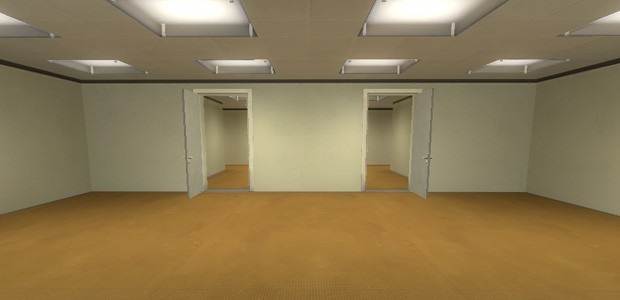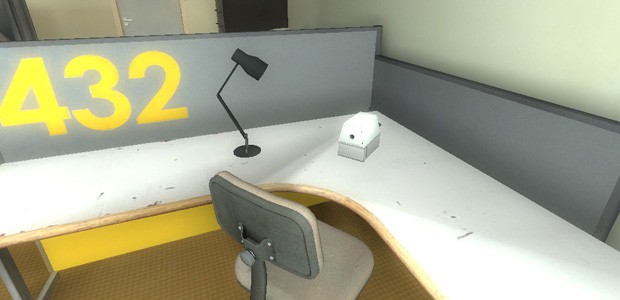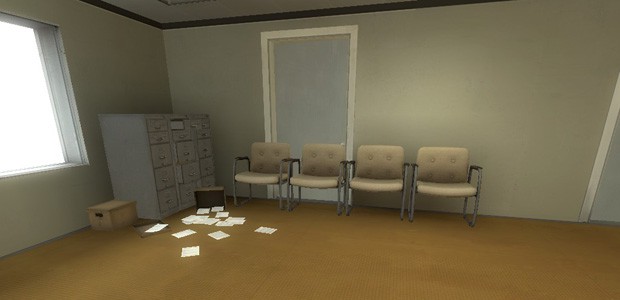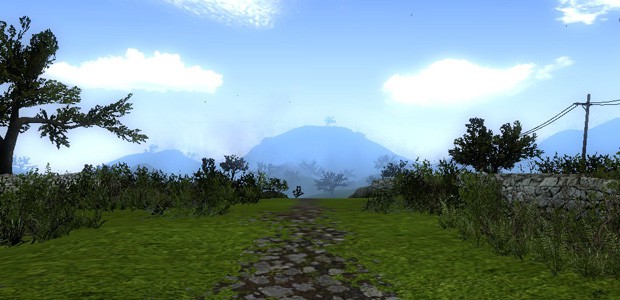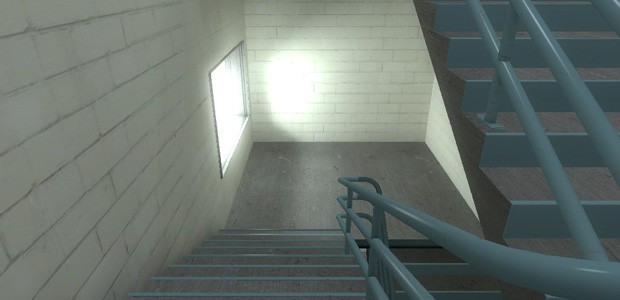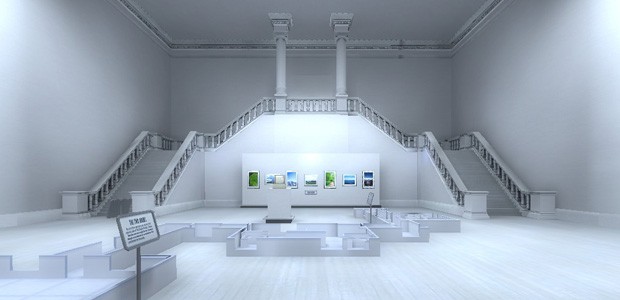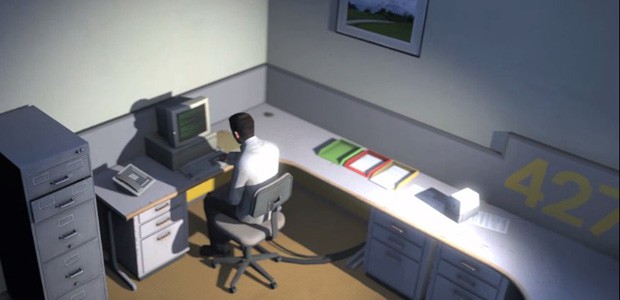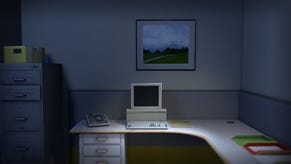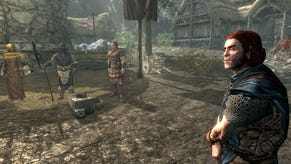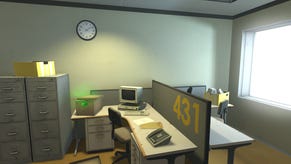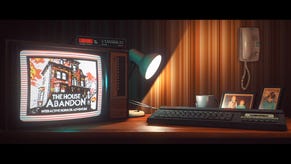The Impossible Architecture Of The Stanley Parable
Impossible corridors and the building as character
About a year ago I interviewed Davey Wreden and William Pugh about the architecture of The Stanley Parable but never published the article. I'd been thinking about how the game intertwines narration and level design for a while, but it was a gif which finally converted solo pondering into getting the pair on Skype. Here's what happened when Wreden and Pugh dug into the ideas behind The Stanley Parable's disorienting and utterly impossible building.
CAUTION: There will be spoilers.
"The two doors is definitely the purest choice," says Pugh.
He is talking about that first decision in the game. Do you go left as the narrator dictates or do you go right in your first act of open defiance?
"That's completely symmetrical," he says. "We didn't want to feel like the player was being pushed by the game world. We didn't want that to overshadow the narrator at that point. When you get there for the first time we've got to manage very carefully what information the player has when making decisions. If we'd made one corridor darker and one lighter that would have spun it in a different direction. We want that [choice] to be the first step in the relationship the player takes with the narrator and we didn't want the level design to get in the way there."
The narrator's bias was one of Pugh's guiding principles when designing the office space. Through development he kept returning to the question, "What would the narrator think an office would look like?" If you try exploring the game with this phrase in mind you start noticing what's lacking – wastepaper baskets, keyholes for locked doors, coffee machines despite the multiple cups of coffee, employee toilets – things which might be omitted from a cursory narrative description as functional rather than important to the story.
The relationship between the narrator's script and the space in which you play is the result of an ongoing dialogue of tweaks between Wreden and Pugh. One of the two would add an element make a change and the other would respond by adding their own tweaks and ideas. Maybe Pugh would make a change to the environment and Wreden would see it and use it to flesh out his understanding of the narrator.
"A lot of the depth and granularity of detail in the narrative and the environment came because over the course of development there were so many ping pong moments," says Wreden. "What if this were part of the environment? What would this mean for the narrative? I think employee 432 is prob the best example of that."
According to Pugh employee 432 pre-dates almost everything else in the game. "When we were bored and making an environment or something I'd keep adding loads of little things in the game all referencing 432, then towards the end we thought we'd just go a bit crazy and put a load of things around all referencing employee 432. We're really happy because people went crazy and started theorising about it."
There's actually a break in the transcription here because Pugh and Wreden started googling employee 432 to send me an image and got caught up excitedly clicking through a bunch of posts from players chatting about the importance of 432. "There was a seed planted," says Wreden, "and all of the details were little opportunities throughout development. We can add something there or over here. To see people play it and pick up on those details is really fascinating."
But back to the main space itself – the impossible office.
"It's interesting how the design of the space changed over development," says Wreden. "It had previously been an office, a building, a theoretical space somewhere. There was a point that was crucial for me where we decided that we wanted the space to feel really alive. To do that we started changing the actual layout and design as you play. Some of the changes are more subtle than others but I feel like what we were trying to get at was a space which literally feels unknowable because it's morphing and melding around your expectations and knowledge of it. I came to see the building as another character. I felt it was really powerful for players to continually rediscover the office itself – the actual building."
That repetition and rediscovery was key to Pugh too. "There's a load of interesting stuff I got to do with Stanley because you're moving through this space more than once. You know it but then you don't anymore. In some really monotonous buildings you can find a place that looks like another place and you turn a corner and oh no! I'm not over there, I'm all the way over here. That was a really fun effect we could get with the Confusion Ending." (The game, as you probably know, has a number of endings – this one involves a series of narrative resets as the narrator grows ever-more frustrated at his inability to find the story.)
"Usually people had played through the game a few times before they got there. They start in the opening section and the narration is all the same so they're planning in their head that they'll go left then right and so on to get to a different ending but before they can make the first choice it brings you back into a different kind of space." The narrator's dictation of and response to the space ends up functioning as a kind of unreliable audio signage system.
"There's a great article [it's the one by Electron Dance's Joel Goodwin] about The Stanley Parable which put it into words I've never said before but they felt so true – that when you follow everything the narrator says and exit out of the big giant door the game takes a hold of the camera and walks you straight forward. It's the most frustrating moment in the entire game because all you want to do is turn around and look at where you've been. To see what is this building? What is this structure I've been inside? From the inside it's so unknowable."
Pretty much everything beyond the deliberately balanced first left or right choice has a degree of manipulation applied to the level design. For example you can choose to go up or down a set of stairs. "There's a lot of sound design in that," says Pugh. "As you climb higher the sound opens up slightly so it's less claustrophobic. If you go down it's a lot more tense and in your face. It's something people don't notice but it's there and subconsciously informs their perception of the space they're in.
"With the escape path or the mind control facility, the lighting there is important. In The Stanley Parable if we lit it realistically it would look horrible so we've had to use a lot of simulated lighting and invisible lamps to bring it to a nice light. That helped play a lot with how players perceive a space. Like the red and blue door. If you keep taking the blue door the space is transformed by the lighting. At the start there's natural light flowing onto the red door to promote this kind of positive nice feeling there but as you continually disobey, the lighting gets a lot more ugly – the fluorescent lamp turns on and makes an ugly noise."
In terms of more obvious level design sleight of hand, you might become aware that one corridor is much longer than another, despite their placement indicating they should be identical. Perhaps you saw an impossibly-placed window, or encountered the story strand which creates a sudden corridor as you turn a corner – a workplace version of the Penrose triangle. Maybe you noticed that the windows are just white shapes, providing no locational cues whatsoever.
"The game has in general far more content than most people will see when they play it," says Wreden. "But what's important is they see enough of it and are unsettled by enough of it. The design of the architecture, especially the way the architecture changes each time you play, [has] a gradient of physical paradoxes, some smaller some bigger. It no longer becomes one particular way the architecture is changing. It becomes many ways and then your imagination takes over. Every room might change. It becomes impossible to know and the way the player projects that uncertainty onto the architecture is what gives it life."
There's one ending which involves a museum exhibition devoted to the game itself. On the surface it appears to offer a moment of honesty within The Stanley Parable's continual mood of uncertainty. Obviously that honesty turns out to be a lie, but one which the pair struggled with and which is, ultimately, the source of Pugh's one regret when it comes to the game.
The exhibition contains a number of artefacts relating to the game – a diagram regarding the story branches at the beginning of the game, a little diorama of (a version of) the office, that sort of thing. It's at this point the narrator, now with a female voice, tells Stanley he is already dead and is treading pre-determined paths. It's a moment which makes explicit that tension between the building as it appears and the reality of the design – unknowable versus tightly choreographed and scripted.
"I love [that tension]," says Wreden. "I think it's beautiful. I think the beauty of the section is we had a goal with that museum and the goal was create one space of actual honesty. That was important." He then does exactly what the game does and undermines that sentiment. "We're not going to lie but at the same time we're still kind of lying. We could explain everything and it still wouldn't – you're still bringing more to it than we could ever make sense out of. We can show you the guts of the thing but it's not going to clarify what you as a player are projecting onto this space that makes it seem more alive than it actually is."
Wreden refers to the museum as a refreshing opportunity to speak a little more directly to the player. But Pugh is slightly more hesitant.
"I think, in terms of regrets about development, we could have made that space a bit more honest. We were still kind of constrained by having a time limit to make the game and we had to give the impression of what we wanted to do. To make it properly honest would have taken more time and we didn't have that."
The overriding concern when it came to honesty was not wanting to spoil the game, particularly if a player came across the Museum Ending early on. "In the version we released there was a map of the opening section, but before there was a diagram of the entire game with all the endings laid out in front of you," says Pugh. "We went back and forth on that for ages."
"It just really killed the experience," says Wreden. "We were too honest and people didn't want it. we gave up too much of the understanding of the space and people began to reject it. I get emails from people all the time that are like can you just explain it all to me and I'm like 'You don't want that. You think you do but…' It needed not to kill the magic."
I've played a lot of The Stanley Parable and we are deep into the discussion so Wreden and Pugh decide to show me the diagram of all the game's endings, although they ask me not to share it. They used it to keep track of the work they were doing and prioritise pathways for completion. "This image saved our lives during development," says Pugh. "When we were feeling really shit and there was so much left to do we could look at it and see what we needed to do next."
Wreden laughs. "Of course, that wasn't quite the truth either but at least it was a lie we could convince ourselves."
I have one more question and it's about Stanley.
"Is Stanley important?"
I mean, he has his own office so architecturally he feels slightly elevated, but the changeable nature of the building makes the legibility of the corporate hierarchy equally unreliable.
"I think about that all the time," says Wreden. "I don't have an answer for you. I seriously wonder that all the time."
"I don't think he should get ahead of himself," says Pugh.
This article was originally published as part of, and thanks to, the RPS supporter program.

